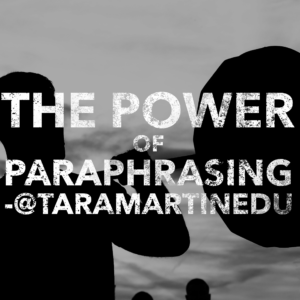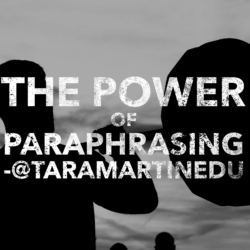While conversing with another individual, be it a coaching conversation or just chatting with my hubby, sometimes I find myself needing a bit of clarification to better understand the perspective of the one speaking. Often, one will feel the need to ask a question to clarify. However, I find that asking questions might make the one sharing feel interrogated or the need to defend their thought. While that isn’t the intention whatsoever of the listener, it might come across as such. Therefore, I have tried to stick to paraphrasing the speaker’s thoughts and pausing shortly afterward. By responding in this manner, I’m letting the person know that I am listening intently, recognizing what they might be feeling and validating their interests. Wellman and Lipton explain it like this, “The paraphrase reflects a speaker’s thinking back to the speaker for further consideration.”
 I’ve been in awe at the misunderstandings that have been brought to my attention after paraphrasing my perception to the one visiting with me. What I thought I heard wasn’t at all on the right track. However, their quick clarification helped the conversation keep a steady flow.
I’ve been in awe at the misunderstandings that have been brought to my attention after paraphrasing my perception to the one visiting with me. What I thought I heard wasn’t at all on the right track. However, their quick clarification helped the conversation keep a steady flow.
While you don’t want to sound robotic, I found myself becoming more natural after practicing with a few simple phrases shared by Wellman and Lipton in Mentoring Matters. I don’t recommend using these all the time, but they might provide a starting point.
” • So, it sounds like you’re feeling…
• You’re noticing that….
• There seems to be two key issues here ______ and _______
• You’re concerned about….”
(The above phrases will likely NOT work on your spouse or close friend. Just sayin…)
A few of my personalized go-to’s are:
• What I hear you saying is …
• Correct me if I’m misunderstanding, but it seems….
• So, I sense you’re feeling a bit of … (frustration, exhaustion, weariness, etc.)
If a staff member has an extensive list of things causing them to feel disgruntled, and they share it all in one big rant, I often try to work on narrowing it to two or three main discussion points. Your working memory can only hold two to five things at one time. Therefore, by selecting a few details to focus on seems like a more productive use of a conversation. My paraphrase in this situation might sound something like,
• Wow, you have a lot on your plate right now. (pause) It sounds to me like ____ and ____ might need some special attention at this time. (pause)
By validating one’s emotions and concerns, I find I’m able to either
1) move deeper into the conversation or
2) better understand their viewpoint by allowing them to explain it in more depth.
Either way, both the speaker and the listener gain perspective by the power of paraphrasing. It truly is an essential conversation tool when used authentically. It works well with students, too. How often do we misunderstand them and neglect to seek further interpretation?
I’d love to hear your thoughts on paraphrasing or other communication-hacks that help you better understand the speaker while becoming a more attentive listener.


